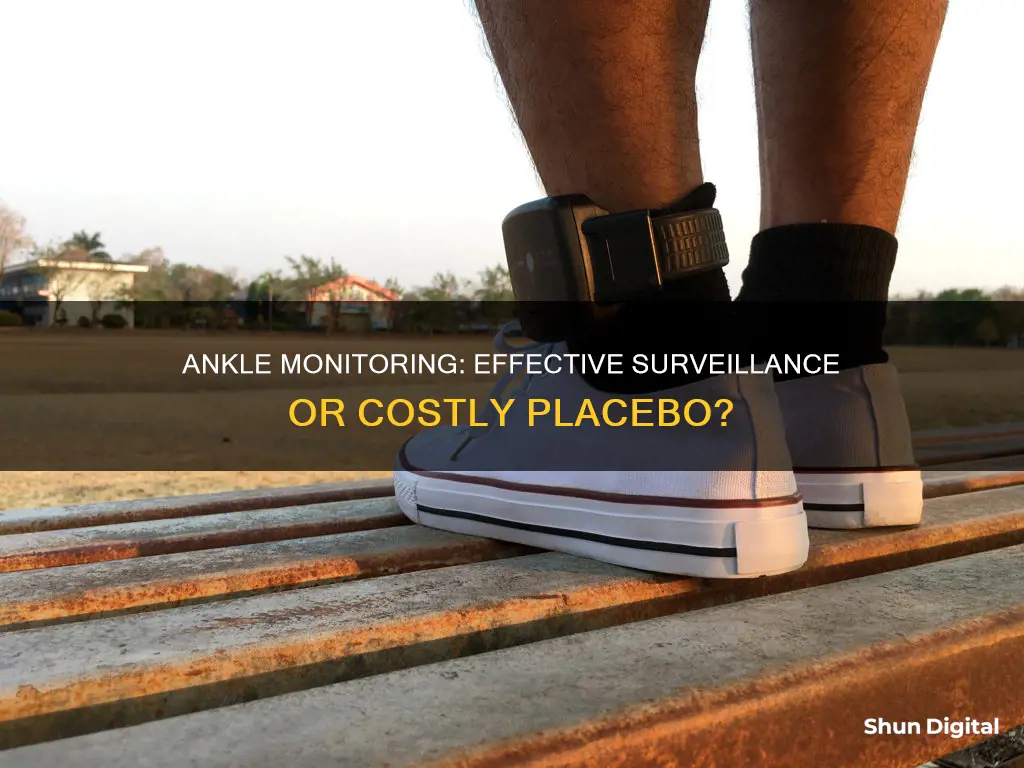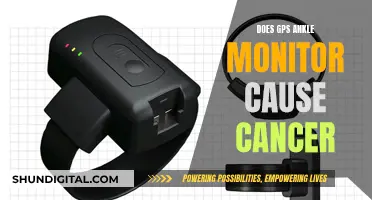
Ankle monitors, also known as ankle bracelets, shackles, or tethers, are electronic monitoring devices used as an alternative to incarceration. They are typically locked around the wearer's ankle to track their movements and activities using GPS or RF technology. While some consider them a creative solution to reduce prison populations, others argue that they are faulty, imprecise, and disruptive. The reliability of ankle monitoring is questionable, with reports of frequent alerts, signal losses, and negative impacts on the lives of those monitored. The high costs associated with these devices can also lead to financial burdens, especially for households with recently incarcerated members.
| Characteristics | Values |
|---|---|
| Use | To track the movements and activities of defendants awaiting trial, convicted offenders on parole or probation, and undocumented immigrants |
| Technology | GPS, RF, and SCRAM |
| Effectiveness | Studies show that monitors fail to demonstrably meet their stated goals of ensuring court appearance, protecting public safety, and advancing rehabilitation. |
| Cost | Fees to wear a monitor range from $3 to $35 a day, with initial setup charges ranging from $100 to $200. |
| Issues | Skin irritation, restricted movement, social isolation, stress, and disruption to daily life. |
What You'll Learn

Ankle monitoring as an alternative to incarceration
Ankle monitoring has been increasingly viewed as a more humane alternative to incarceration. However, several concerns have been raised about the effectiveness of this method and its potential negative impact on individuals.
During the COVID-19 pandemic, the use of ankle monitors rose significantly as jails released incarcerated people due to the risk of coronavirus outbreaks. While ankle monitoring can provide individuals with the opportunity to live in their homes rather than being in jail, there are questions about the rehabilitation it offers and the restrictions it imposes.
One of the main issues with ankle monitoring is the potential violation of privacy rights. The monitors capture and store location and movement data, which is often shared with law enforcement agencies and courts. This lack of privacy can impact the privacy of not only the individual wearing the monitor but also their family and friends, who may be subjected to invasive home searches.
Another concern is the financial burden associated with ankle monitoring. Most jurisdictions require individuals to pay expensive user fees, which can range from $2 to $20 per day, or $2,800 to $5,000 per year, including other costs such as court expenses and phone/internet service charges. These fees can be particularly challenging for individuals from underprivileged backgrounds, and the private companies that dominate the electronic monitoring market profit from these fees.
Additionally, ankle monitoring can create obstacles to employment and disrupt family and social relationships. Individuals may face difficulties in adjusting their approved movement hours to accommodate work and school commitments. The restrictions on movement can also lead to social isolation and stress, exacerbating mental health issues such as depression and anxiety.
While ankle monitoring can provide an alternative to incarceration, it is important to recognize that it imposes its own set of challenges and restrictions. These can include technical issues, vague and overly broad rules, and the potential for reincarceration for minor technical violations. Therefore, while ankle monitoring may offer a creative solution to reduce prison populations, it is crucial to address the concerns associated with this method to ensure the fair and effective rehabilitation of individuals.
LED vs LCD: Battle of the Glare
You may want to see also

The cost of ankle monitoring
In addition to the daily usage fees, there may be other costs associated with ankle monitoring. Some states or counties charge monthly fees that go to the probation company monitoring the device, which can range from $30 to $60 per month. There may also be additional costs for things like landline phone connections, which are required in some areas.
The cost of the ankle monitor device itself is also significant. The devices can cost the government anywhere from $800 to $1,500 each. This cost is often passed on to the wearer, either directly or through daily usage fees.
The high cost of ankle monitoring has been criticised by civil liberties groups, who argue that it places an unfair burden on people who are already marginalised. In some cases, people may be forced to plead guilty or return to jail because they cannot afford the cost of the monitor. This has led to calls for reforms, such as sliding-scale fees based on income, to make ankle monitoring more accessible and fair.
Overall, the cost of ankle monitoring can be a significant barrier for people who are trying to reintegrate into society after a conviction. While the technology may offer some advantages over incarceration, the financial burden it imposes can create additional challenges and hardships for those trying to rebuild their lives.
Asus Monitor Warranty: How Long Does It Last?
You may want to see also

The effectiveness of ankle monitoring
Ankle monitoring is a tool used in community corrections to promote accountability and compliance. It is highly regarded within the industry and its use has become very popular over the last few years. People wearing an ankle monitor has more than doubled from 2005 to 2015, with over 125,000 people tracked in the US alone in 2015.
Ankle monitoring is seen as a creative way to allow people to live in their homes who may otherwise be in jail. It is also considered a positive alternative to mass incarceration as it lets people pay their debt to society while still providing for their families. Ankle monitors support a successful transition from incarceration to the community, allowing individuals to serve a portion of their sentence outside of prison.
Scientific studies have shown that ankle monitoring is cost-effective, helps reduce prison populations, and reduces an individual’s chances of returning to jail. For example, a study by the District of Columbia Crime Policy Institute found that on average, ankle monitoring reduces arrests by 24% for program participants, and saves local and federal agencies money. Another study by the Journal of Criminal Justice concluded that ankle monitoring "has been shown to produce positive effects for certain offenders (such as sex offenders), at certain points in the criminal justice process (post-trial instead of prison), and perhaps in combination with other conditions attached (such as geographic restrictions) and therapeutic components".
However, there are concerns about the effectiveness of ankle monitoring. Some studies suggest that ankle monitors may be less effective in discouraging further crimes by the wearer than other rehabilitation programs. There are also concerns about the technology behind ankle monitors, with reports of monitors losing their GPS signal, causing disruptions in classrooms, and being uncomfortable and stressful for the wearer. In addition, the high fees associated with wearing an ankle monitor can be a burden for individuals and their families, and the stigma and social isolation that result from being monitored can exacerbate depression and anxiety.
Overall, while ankle monitoring can be an effective tool for community corrections and reducing prison populations, there are concerns about its technological limitations, cost, and impact on the well-being of the wearer.
Setting Up an Internal Camera for Your ASUS Monitor
You may want to see also

Ankle monitoring and systemic inequities
Ankle monitoring, also known as electronic monitoring, has become an increasingly popular alternative to incarceration, with the number of active monitors in use in the US rising by 140% from 2005 to 2015. While it may be seen as a creative way to allow people to live in their homes instead of jail, ankle monitoring has been criticised for its negative impact on marginalised communities and failure to meet its stated goals.
Systemic Inequities
Electronic monitoring has been criticised for exacerbating systemic inequities along lines of race, class, and disability. In Detroit, for example, Black people are twice as likely as white people to be subjected to electronic monitoring. This disparity is further compounded by the high cost of wearing a monitor, which can range from $3 to $35 per day, in addition to initial setup charges of up to $200. These fees can amount to hundreds of dollars per month, creating a financial burden for households, particularly those already struggling with the return of an incarcerated family member.
Social Stigma
The stigma associated with wearing an ankle monitor can lead to social isolation and stress, exacerbating mental health issues such as depression and anxiety for the wearer. The monitors are often visible, leading to public judgement and further marginalisation. This stigma can make it difficult for individuals to reintegrate into society, find employment, and access basic necessities.
Restricted Movement
Ankle monitoring restricts the movement of individuals, limiting how long they can stay outside and where they can go. This can lead to a loss of connection with family and community, negatively impacting mental health and well-being. In some cases, individuals may be unable to leave their homes at all, even for essential activities such as buying groceries or seeking medical care.
Financial Burden
In addition to the daily fees, individuals may be required to pay for any damage to the monitoring device, including water damage or lost parts. The cost of these repairs or replacements can be significant, and failure to pay may result in further legal consequences or extended monitoring periods. This financial burden can be especially challenging for those from low-income backgrounds, potentially leading to job loss, housing instability, and further entanglement with the criminal justice system.
Recommendations for Reform
The ACLU has released a report, "Rethinking Electronic Monitoring: A Harm Reduction Guide", which calls for jurisdictions to replace electronic monitoring with less restrictive measures such as court reminders and transportation assistance. The report urges officials to strictly limit the use of electronic monitoring, eliminate discrimination based on wealth and housing status, reasonably accommodate disabilities, and ensure privacy and data protection for those being monitored.
Mounting an ASUS Monitor: A Creative Solution for Hole-less Designs
You may want to see also

Ankle monitoring and alcohol consumption
Ankle monitors are used to track the movements and activities of defendants awaiting trial and convicted offenders on parole or probation. They are also used to monitor alcohol consumption in DUI cases, where the court orders the defendant to wear the bracelet for a set period, typically 60 to 90 days. These devices, known as SCRAM bracelets (Secure Continuous Remote Alcohol Monitoring), provide courts with a way to monitor offenders who are not supposed to be drinking alcohol.
The SCRAM bracelet tests the wearer's perspiration every 30 minutes, 24 hours a day, to detect the presence of alcohol. When a person consumes alcohol, a small amount is excreted through the skin in the form of insensible perspiration, which the SCRAM bracelet can detect. The data is then uploaded and monitored by a private company, which reports any positive alcohol tests to the court. This continuous monitoring eliminates testing gaps and discourages drinking around test schedules.
In addition to DUI cases, SCRAM bracelets may be ordered in other situations involving alcohol abuse, such as family court, domestic violence cases, underage drinking, and substance abuse charges. The use of these bracelets has been shown to increase compliance with court orders and enhance community safety. They also support long-term behaviour change and complement treatment for alcohol dependence.
However, there are concerns about the accuracy of SCRAM bracelets, as they can give false readings. While false positives are rare, products containing alcohol, such as perfume, lotions, mouthwash, and hand sanitiser, can potentially trigger the monitor. Additionally, the bracelets can be uncomfortable, causing skin irritations for some wearers.
Asus Monitors: What Cables Are Included?
You may want to see also
Frequently asked questions
Ankle monitors use GPS technology or radio frequency to transmit location data to a monitoring centre, ensuring compliance with court-ordered movement restrictions. They are usually locked into place to allow for ongoing, accurate monitoring.
While the use of ankle monitors is becoming more common, the technology is still faulty and imprecise. Monitors can cause a lot of alerts and information overload, and they only work when they are charged, have a GPS signal, and are on or near the person.
Ankle monitors are used by people on parole, people who have been bailed awaiting trial, people serving probation, people facing immigration proceedings, and people under house arrest.







